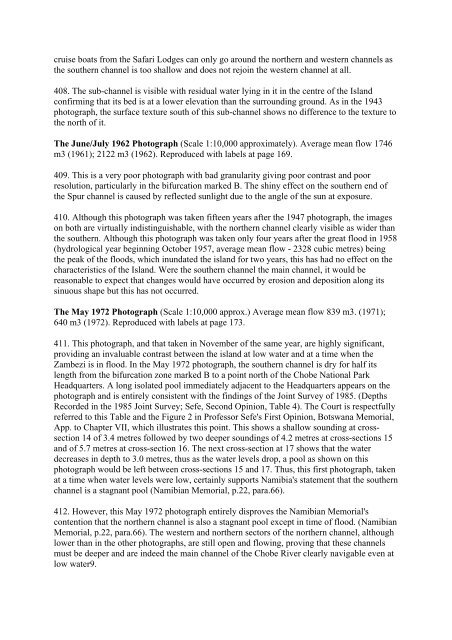botswana/namibia - Cour international de Justice
botswana/namibia - Cour international de Justice
botswana/namibia - Cour international de Justice
Create successful ePaper yourself
Turn your PDF publications into a flip-book with our unique Google optimized e-Paper software.
cruise boats from the Safari Lodges can only go around the northern and western channels as<br />
the southern channel is too shallow and does not rejoin the western channel at all.<br />
408. The sub-channel is visible with residual water lying in it in the centre of the Island<br />
confirming that its bed is at a lower elevation than the surrounding ground. As in the 1943<br />
photograph, the surface texture south of this sub-channel shows no difference to the texture to<br />
the north of it.<br />
The June/July 1962 Photograph (Scale 1:10,000 approximately). Average mean flow 1746<br />
m3 (1961); 2122 m3 (1962). Reproduced with labels at page 169.<br />
409. This is a very poor photograph with bad granularity giving poor contrast and poor<br />
resolution, particularly in the bifurcation marked B. The shiny effect on the southern end of<br />
the Spur channel is caused by reflected sunlight due to the angle of the sun at exposure.<br />
410. Although this photograph was taken fifteen years after the 1947 photograph, the images<br />
on both are virtually indistinguishable, with the northern channel clearly visible as wi<strong>de</strong>r than<br />
the southern. Although this photograph was taken only four years after the great flood in 1958<br />
(hydrological year beginning October 1957, average mean flow - 2328 cubic metres) being<br />
the peak of the floods, which inundated the island for two years, this has had no effect on the<br />
characteristics of the Island. Were the southern channel the main channel, it would be<br />
reasonable to expect that changes would have occurred by erosion and <strong>de</strong>position along its<br />
sinuous shape but this has not occurred.<br />
The May 1972 Photograph (Scale 1:10,000 approx.) Average mean flow 839 m3. (1971);<br />
640 m3 (1972). Reproduced with labels at page 173.<br />
411. This photograph, and that taken in November of the same year, are highly significant,<br />
providing an invaluable contrast between the island at low water and at a time when the<br />
Zambezi is in flood. In the May 1972 photograph, the southern channel is dry for half its<br />
length from the bifurcation zone marked B to a point north of the Chobe National Park<br />
Headquarters. A long isolated pool immediately adjacent to the Headquarters appears on the<br />
photograph and is entirely consistent with the findings of the Joint Survey of 1985. (Depths<br />
Recor<strong>de</strong>d in the 1985 Joint Survey; Sefe, Second Opinion, Table 4). The <strong>Cour</strong>t is respectfully<br />
referred to this Table and the Figure 2 in Professor Sefe's First Opinion, Botswana Memorial,<br />
App. to Chapter VII, which illustrates this point. This shows a shallow sounding at crosssection<br />
14 of 3.4 metres followed by two <strong>de</strong>eper soundings of 4.2 metres at cross-sections 15<br />
and of 5.7 metres at cross-section 16. The next cross-section at 17 shows that the water<br />
<strong>de</strong>creases in <strong>de</strong>pth to 3.0 metres, thus as the water levels drop, a pool as shown on this<br />
photograph would be left between cross-sections 15 and 17. Thus, this first photograph, taken<br />
at a time when water levels were low, certainly supports Namibia's statement that the southern<br />
channel is a stagnant pool (Namibian Memorial, p.22, para.66).<br />
412. However, this May 1972 photograph entirely disproves the Namibian Memorial's<br />
contention that the northern channel is also a stagnant pool except in time of flood. (Namibian<br />
Memorial, p.22, para.66). The western and northern sectors of the northern channel, although<br />
lower than in the other photographs, are still open and flowing, proving that these channels<br />
must be <strong>de</strong>eper and are in<strong>de</strong>ed the main channel of the Chobe River clearly navigable even at<br />
low water9.

















